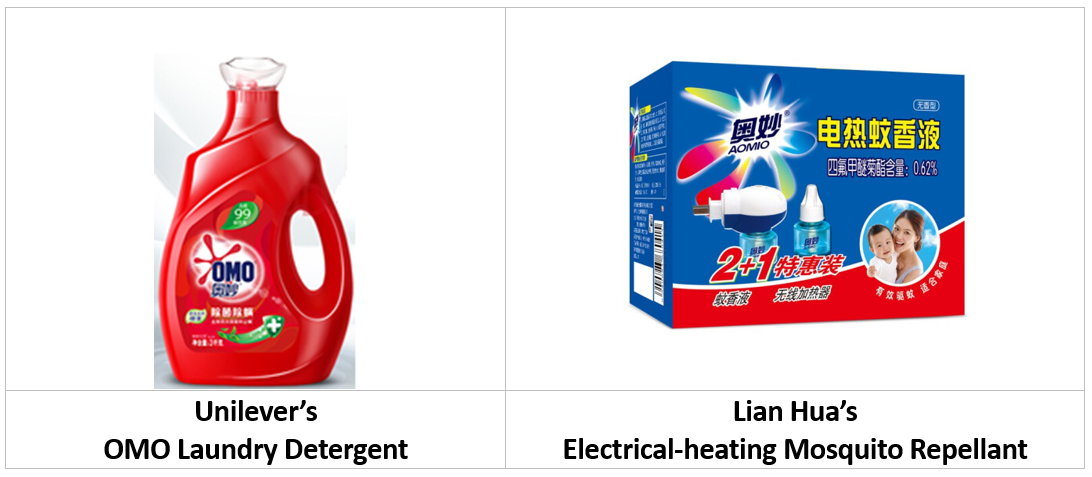Beijing High Court grants Unilever’s OMO well-known trademark status in an administrative proceeding (2021)
Ye Cai, 28 November 2021
In China, there are two different legal systems which are used for the protection of GIs: (1) the trademark system established by the China Trademark Office (CTMO), now under the China National Intellectual Property Administration (CNIPA); and (2) a sui generis protection system.
Unilever owns “OMO” and its Chinese equivalent mark “ ” trademark registrations in China, designating laundry preparations and other goods in class 3. Through decades of use and promotion, Unilever’s OMO marks have built strong brand awareness among the Chinese consumers.
” trademark registrations in China, designating laundry preparations and other goods in class 3. Through decades of use and promotion, Unilever’s OMO marks have built strong brand awareness among the Chinese consumers.
On 5th February 2013, a local company Wuxi Lian Hua Daily Commodities Technology Co., Ltd. (Lian Hua) filed a trademark application for  no. 12156179 (the Mark) on goods “Germicidal burners; Heating apparatus, electric, among others” in class 11 and obtained registration on 6th September 2014. Lian Hua also uses the stylized form of the Mark, surrounded by splashed water device, which highly resembles Unilever’s OMO marks.
no. 12156179 (the Mark) on goods “Germicidal burners; Heating apparatus, electric, among others” in class 11 and obtained registration on 6th September 2014. Lian Hua also uses the stylized form of the Mark, surrounded by splashed water device, which highly resembles Unilever’s OMO marks.
Comparison of both parties’ products

On 28th February 2018, Unilever initiated an invalidation action against the Mark before the China National Intellectual Property Administration (CNIPA), but to no avail.
In 2019, Unilever brought an administrative proceeding before the Beijing Intellectual Property Court, which opined that:
• OMO’s Chinese mark had reached well-known in China before the filing of the Mark;
• The designated goods of the Mark are associated with OMO’s reputable products, considering their overlapping function, sales channels and target consumers.
• The Mark is identical with OMO’s Chinese mark, and if used on the designated goods, may give rise to the consumers’ association with Unilever’s OMO marks, which is detrimental to Unilever’s interests attached to its well-known trademark.
Based on the above finding, the Court ruled to invalidate the Mark, citing Article 13.3 of China’s Trademark Law on 19th December 2019.
Lian Hua later appealed before the Beijing High Court, which upheld the decision of the Trial Court on 26th August 2021.
China’s Supreme People’s Court elucidates in its decision (2016) Zui Gao Fa Xing Zai No.13 re The Procter & Gamble Company v. TRAB and Shantou Weishida Cosmetics Co., Ltd. that "To determine whether the applicant is acting in bad faith, all relevant factors must be taken into consideration ..... The mere fact of being well-known is insufficient. The court shall consider the subjective intention, the objective behavior and all relevant factors". In plain English, assessment of the applicant’s bad faith shall be based not only on the circumstances existing at the date of filing, but also on its behavior after the date of filing.
Lian Hua’s registered trademark is a slavish copy of Unilever’s “OMO” well-known trademark, which exhibits its bad faith at the time of filing. In actual use of the litigious trademark, Lian Hua mimics the font, the color and the background pattern (splashed water) of Unilever’s OMO laundry detergent, which substantiates its bad faith after the date of filing.
Article 11.3 of the “Beijing High People’s Court Guidelines for the Adjudication of Cases Involving Granting and Affirmation of Trademark Right” enumerates the elements to be factored in granting protection over a well-known trademark. It reads:
“The protection scope of a well-known trademark shall be determined by taking comprehensively into account this trademark's distinctiveness, reputation, the extent of similarity between the trademarks, the designated goods, to what extent the relevant public of the trademarks overlaps and the extent of attention of the relevant public, the subjective state of the applicants of the litigious trademark, among others.”
The Beijing High Court’s guidelines aligns with the SPC’s reasoning in the Weishida case that bad faith can be proven by examining facts that take place after the date of filing of the litigious trademark.
This is the first judicial well-known trademark recognition of OMO’s Chinese mark. The recognition will be conducive to OMO’s future trademark enforcement action in China.




